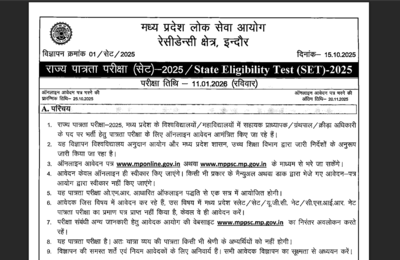JEE Main 2026 registration window to open soon: 6 recent changes engineering aspirants should know

The National Testing Agency (NTA) is set to open the registration window for JEE Main, the engineering entrance exam that determines admission to premier technical institutes in India. Aspiring candidates are advised to familiarise themselves with six major changes introduced by NTA that will affect the exam format, eligibility, and overall preparation.These changes aim to streamline the exam process and bring uniformity to the evaluation and ranking system. As the exam date approaches, understanding these updates is critical for engineering aspirants seeking admission to institutions like the Indian Institutes of Technology (IITs) and National Institutes of Technology (NITs).Revised exam pattern removes optional questionsThe JEE Main exam pattern has returned to the pre-pandemic structure. One notable change is the removal of optional questions in Section B, which were introduced earlier to reduce candidate stress. Now, candidates must answer all 25 questions in each subject: physics, chemistry, and mathematics.For Paper 1, aimed at B.Tech aspirants, the exam consists of 75 questions in total, comprising 20 multiple-choice questions (MCQs) and 5 numerical value questions (NVQs) per subject. The removal of optional questions means that all candidates will face the same fixed number of questions, enforcing a more uniform evaluation.Negative marking applies to numerical value questionsAnother significant update is the introduction of negative marking for numerical value questions (NVQs). Previously, only MCQs had penalties for incorrect answers, while NVQs did not. Under the new marking scheme, candidates will lose marks for wrong answers in NVQs as well.This change calls for greater caution when attempting NVQs, as incorrect answers will now directly reduce the total score. Practising precision and accuracy with numerical problems will be essential for aspirants aiming to maximise their results.New tie-breaking rules focus on exam performanceThe tie-breaking criteria for JEE Main ranks have also been revised. Earlier, factors such as the candidate’s age and application number were considered in breaking ties between candidates with equal scores. These factors have now been removed.The new rules prioritise subject-wise performance and error ratios. Candidates with the same total score will be ranked higher based on their marks in mathematics, followed by physics and chemistry. If ties persist, the ratio of incorrect to correct answers in all subjects will be examined, with further scrutiny into individual subjects in the same order. If a tie remains unresolved after all these criteria, candidates will be awarded the same rank.Age limit removed from eligibility criteriaThe age restriction for JEE Main applicants has been eliminated. This update means candidates of any age who meet the educational qualifications can apply, regardless of their age. The removal of the age limit opens opportunities for older aspirants or those who have taken breaks in their education.This change expands access to the exam, allowing a broader range of candidates to participate in the admission process for prestigious engineering institutions.Reduction in exam centres and citiesThe number of exam centres for JEE Main has decreased from 300 last year to 284 this year. The reduction affects both domestic and international locations. International centres have fallen from 24 to 14, with some cities in countries like Australia, Brazil, Canada, and Hong Kong removed.In India, certain states have seen notable changes: Odisha’s exam cities dropped from 23 to 17, Andhra Pradesh lost 12 centres, while Telangana added two new cities. Tamil Nadu removed three cities but introduced two new ones. Maharashtra experienced a slight net increase despite some removals.Note: Candidates should check the updated list of exam centres carefully to select the most convenient location during registration.Syllabus trimmed for focused preparationThe syllabus for JEE Main has been adjusted to eliminate certain topics, following changes made by NTA in the previous year. In physics, chapters on Scalars & Vectors, Vector Addition and Subtraction, Scalar & Vector Products, Unit Vectors, and Resolution of Vectors have been removed.Chemistry has seen the removal of entire chapters such as States of Matter, Surface Chemistry, and General Principles and Processes of Isolation of Metals. Topics related to P-Block elements have also been simplified or deleted.Mathematics remains unchanged from last year’s syllabus, which had already seen the removal of topics like Complex Numbers, Quadratic Equations, Coordinate Geometry, and Three Dimensional Geometry.






